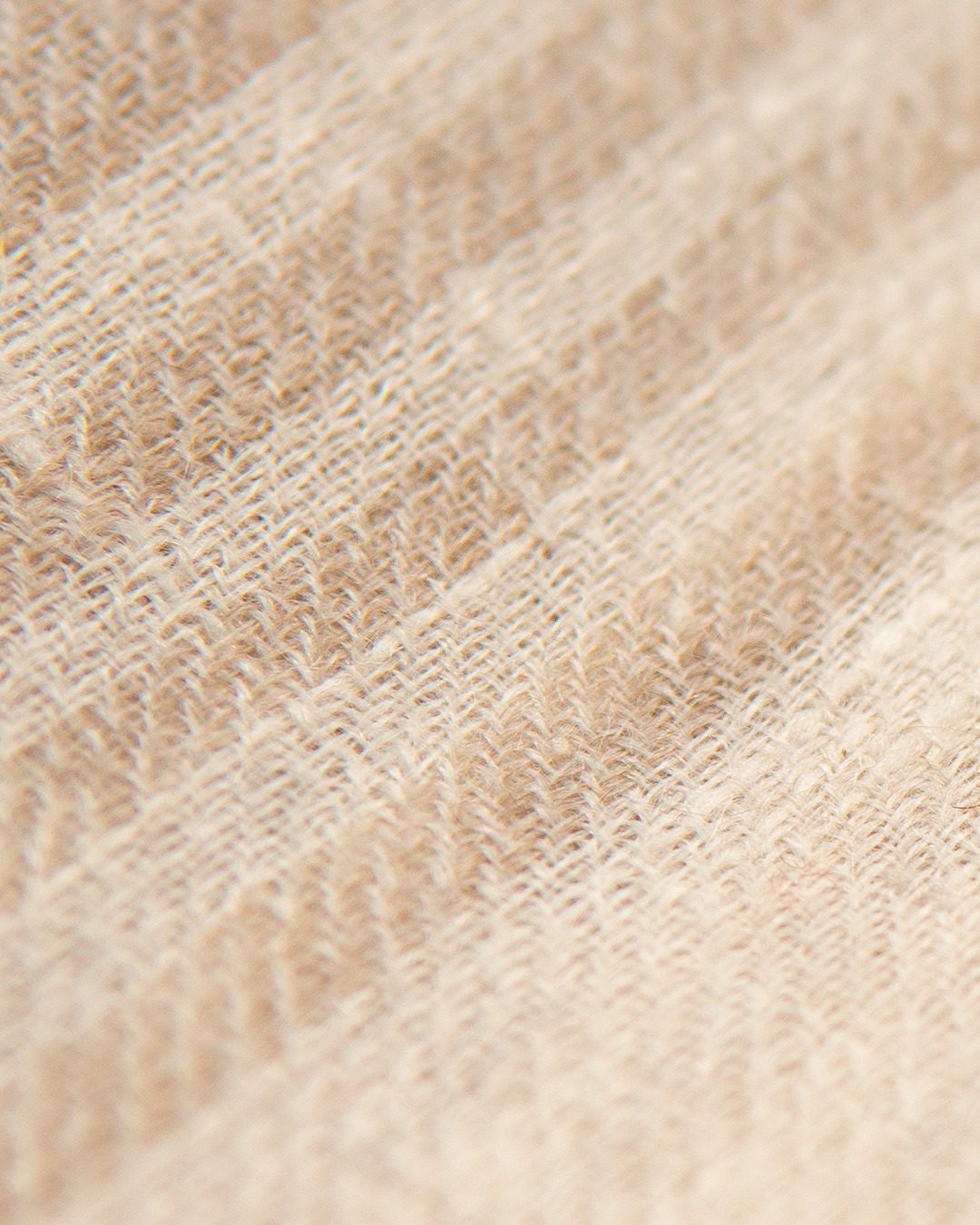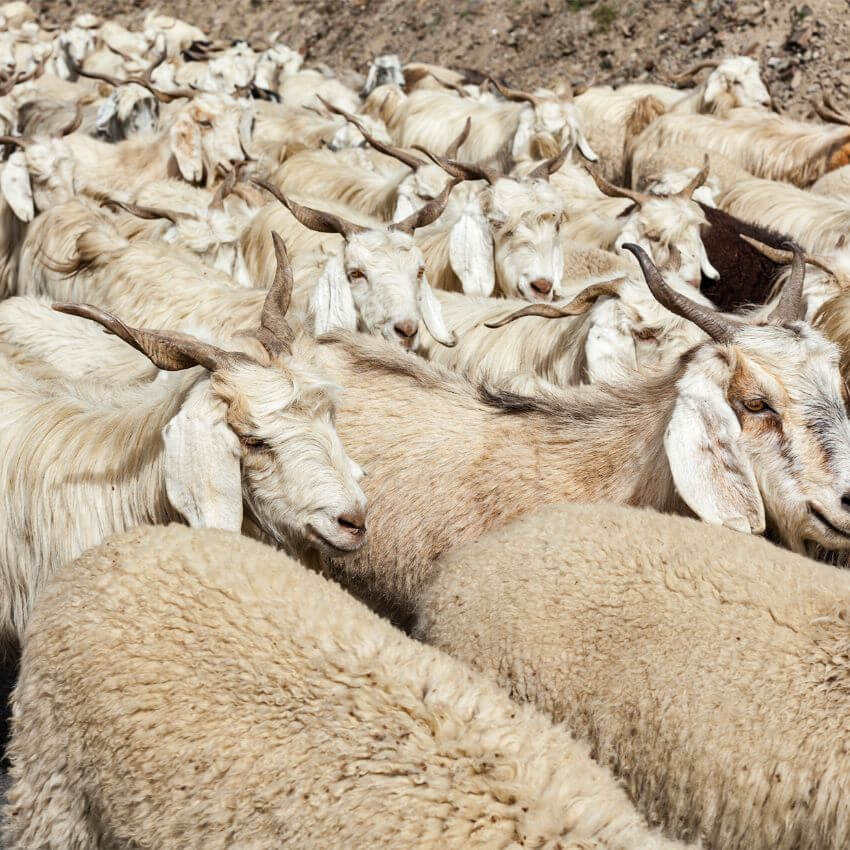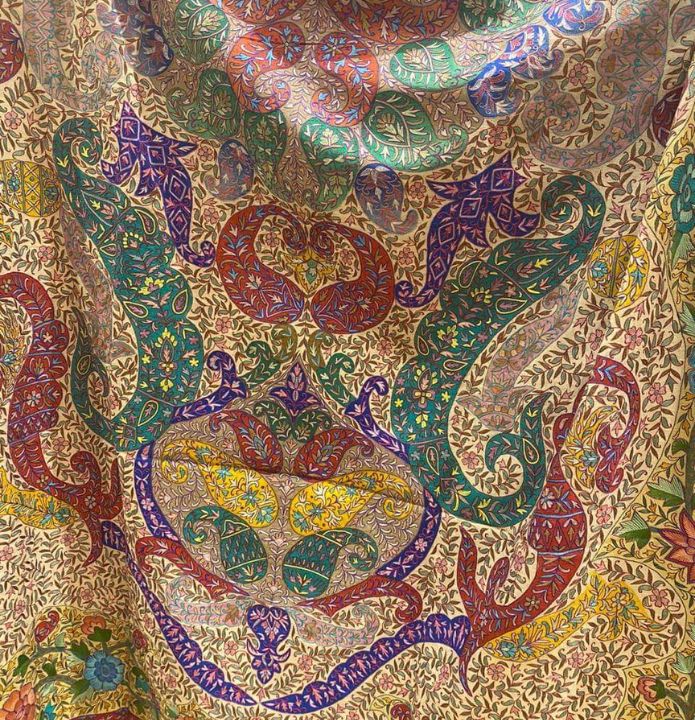DISCOVER
What is
PASHMINA

WHAT IS PASHMINA
Pashmina is a very soft and light fibre obtained from the undercoat of a sub-species of Capra Hircus goat known as Changthangi. It is usually hand-woven into shawls, scarves, wraps, throws, capes and other winter wear accessories. In the early 1990s, pashmina became very popular in Ladakh and Changhtang plateau, and slowly it started appearing in international fashion shows.
Pashmina shawls are made of pashmina wool. Pure pashmina shawls are considered one of the best quality in the market but also costly. Around the world, the word “pashmina“ is used as the type of scarf; in fact, pashmina is called wool itself, with a fibre thickness of 12-16 microns.
So, when we talk about a pashmina shawl or a pashmina wrap, we are referring to a shawl made with the yarn obtained from the undercoat of the Changthangi goat.
Pashminas come in colours like white, orange, brown, black, etc. They can be easily dyed into any colour as per the latest fashion trends. You will often find pashminas with beautiful embroidery work, making them even more special.
WHAT IS THE DIFFERENCE BETWEEN CASHMERE AND PASHMINA
Pashmina and cashmere are two types of wool that are often used interchangeably, but there are some essential differences between the two.
Ladakh pashmina goats are cashmere goats indigenous to the Ladakh region of India. Like other cashmere goats, they produce a fine undercoat fiber that can be spun into yarn. However, Ladakh pashminas are distinguished by their thicker fur, which helps them to withstand the colder temperatures of their mountainous homeland. The pashmina fibres produced by these goats are incredibly soft and have a silky feel, making them highly coveted by textile makers.
Pashmina and cashmere are both soft and durable, but they have some critical differences. One difference is the diameter of the fabric. Pashmina wool is much thinner than cashmere, so it needs to be hand-spun and manually woven to create items like shawls, scarves, and throws. This process is time-consuming and requires a lot of care, but it results in beautiful, extraordinarily soft, warm items. Cashmere, on the other hand, is easier to spin and weave, so it can be used to create a wide variety of items quickly and easily.
WHY IS PSHMINA MORE EXPENSIVE THAN CASHMERE
Pashmina shawls and scarves are synonymous with luxury and high-quality craftsmanship. For centuries, pashmina has been hand-spun in Kashmir using traditional methods passed down from generation to generation.
The gentle spinning process ensures that the fibres remain intact, resulting in a light yet warm fabric, silky yet strong. Pashmina shawls are indeed a work of art, and each one is unique. In contrast, cashmere is typically machine-spun, resulting in a coarser fabric lacking pashmina’s sophistication. Regarding luxury apparel, pashmina remains in a class of its own.
The fibre of pashmina is incredibly soft and has a diameter of 12-16 microns, making it much more delicate than cashmere wool. As a result, pashmina shawls and scarves are considered some of the most luxurious apparel items available. They are exceptionally soft and cosy and also very light and can be easily folded or rolled up for transport.

PROCESSING OF PASHMINA
The pashmina shawl is a luxurious and treasured item, prized for its softness and warmth. But many people don’t realize that pashmina shawls go through a long and complicated process before they are finished.
It all starts with the cashmere goats, who provide the soft wool. The thread is collected and cleaned, and then it is dyed in various colours. Once the dyeing process is complete, the pashmina is ready to be spun into yarn. This yarn is then woven into delicate fabrics, which are finally cut and sewn into the beautiful shawls we know and love.
Each step of this process requires the skill of an expert craftsman, which is why pashmina shawls are so rare and unique.
THE WEAVING PROCESS
Weaving a pashmina shawl involves several steps, from preparing the yarn to finishing the scarf. First, the pashmina wool is spun into continuous lengths of thread, dyed, and washed. Next, the threads are carefully laid out in the desired pattern, with the longest threads (the warp) stretched along the length of the loom.
The weavers then begin to weave in the shorter threads (the weft), creating the intricate design of the pashmina scarf. Finally, the scarf is finished with a fringe or border, and then it is ready to be worn or sold.
For plain shawls, the hanks are not dyed. Instead, once the shawl is ready, it is dyed in the desired colour and sent to the embroiderer.
If, however, the weaver wants to weave Kani shawls, then, in consultation with the designer and the weaver, the amount of yarn required for each colour is calculated. It is then dyed accordingly. Kani shawls are exceptionally intricate, and the different yarn shades help create a beautiful pattern.
The entire process can take several weeks, but the result is a beautiful and unique scarf that will keep you warm for years.


PASHMINA SHAWL’S MOST FAMOUS WEAVES
Pashmina shawls are most commonly available in three types of weave – plain, twill, and diamond. The plain weave is the simplest and most popular type, characterized by a simple over-under pattern.
The twill weave is slightly more complex, with a diagonal pattern that gives the fabric a subtle sheen. Finally, the diamond weave is the most intricate and luxurious type of pashmina shawl weave, characterized by a complex diamond-shaped design.
While all three types of pashmina shawls weaves are beautiful, the diamond weave is the most popular choice for high-end garments due to its luxurious appearance.
THE IMPORTANCE OF BRODERIE
The pashmina shawl has been a staple in many wardrobes for centuries. Whether worn as a fashion statement or to keep warm, these shawls have always been prized for their luxurious feel and elegant drape.
Pashmina shawls are usually made from the softest and finest pashmina wool, making them highly delicate and susceptible to damage. As a result, pashmina shawls must be handled with care. One way to ensure that your pashmina shawl stays in pristine condition is to have it hand-embroidered.
The embroidery adds an extra layer of protection to the shawl, shielding it from being caught on rough surfaces or pulled too tight.
Additionally, the hand embroidery is usually crafted on the twill weave pashmina shawls as they can support the weight of the embroidery better.

THE KANI SHAWLS
The Kani shawl is a type of pashmina shawl that is handwoven and often intricately adorned with embroidery or other designs. It is one of the most expensive and sought-after types of pashmina shawls and has been worn by royalty and dignitaries for centuries.
The Kani shawl is traditionally made from the finest quality pashmina wool, carefully combed and carded by hand to produce the softest and most lustrous fibres. The yarn is dyed in various colours before being woven into the shawl on a loom.
The Kani shawl can take months or even years to complete, depending on the complexity of the design. But the result is a truly luxurious and unique piece of clothing.
IN CONCLUSION
Pashmina has been revered for centuries. Historically, the art of processing pashmina has been highly valued by royalty. Kings, queens, royal families, and nobles worldwide knew pashmina. They had a vast collection of scarves passed down through the generations.
The fame of pashmina has not diminished to this day. Pashmina shawls continue to command a high value and are prized by connoisseurs of the art of creating works from the priceless fibre.
When shopping for pashmina or cashmere products, pay attention to the source of the wool to ensure you’re getting what you want.